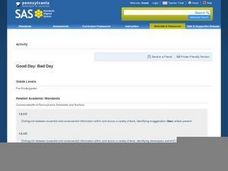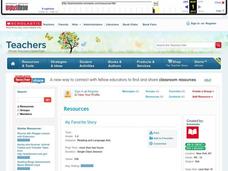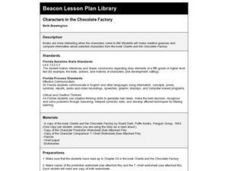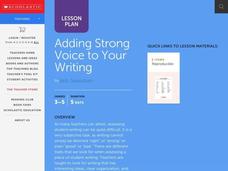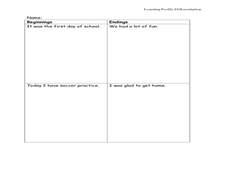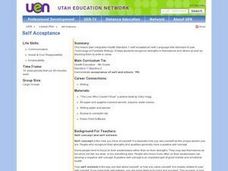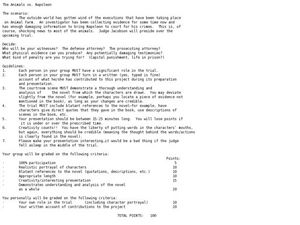Curated OER
The Eight Hero Archetypes
The Chief, the Bad Boy, the Best Friend, the Charmer, the Lost Soul, the Professor, the Swashbuckler, the Warrior. After examining the criteria for each of these archetypes, viewers are ask to generate a list of their own examples of...
Curated OER
Understanding Protagonists and Antagonists
How can you tell if a character is a villain? What about a hero? Work on literary analysis with an engaging language arts worksheet. After completing an activity about the four types of conflict, learners fill out a character map about a...
Curated OER
Good Day/Bad Day
Students read the book Alexander and the Terrible, Horrible, No Good, Very Bad Day and discuss a bad day that they have had. In this bad day lesson plan, students compare their bad day with the story.
Curated OER
Who's Afraid of the Big, Bad Wolf?
Students, at the advanced beginner to low intermediate ESL levels, demonstrate comprehension of the play or story, "Little Red Riding Hood." They construct interviews based on knowledge of the characters in the play Little Red Riding Hood.
Curated OER
My Favorite Story
Students discuss their favorite book. In this book discussion lesson plan, students name the title and tell what makes the book special. Students also review the setting, plot, conflict, and resolution. Students make a book that tells...
Student Achievement Partners
Eleven
Turning 11 comes with a range of emotions. Explore those emotions by reading the short story "Eleven" by Sandra Cisneros. Readers analyze the main character's reactions to the events of her day. Then, they write an essay describing what...
Curated OER
Through the Eyes of the Big Bad Wolf
Imagine how the wolf would tell the tale of Little Red Riding Hood or The Three Little Pigs. Young writers re-imagine classic tales by adopting the point of view of another character in the story. After reading models like The True Story...
Curated OER
Characters in the Chocolate Factory
Students dress and act as selected characters from Roald Dahl's "Charlie and the Chocolate Factory". They identify each other and make predictions about the upcoming chapters based on their observations about the characters.
Curated OER
Adding Strong Voice to Your Writing
Identify examples of strong voice in popular picture books. Young authors add voice to their writing and revise their own writing. In addition, they share their writing with their peers.
Curated OER
"Split" Character Studies in Crime and Punishment
Students write an essay evaluating split character traits on major characters in Dostoevsky's novel Crime and Punishment. In this lesson students are guided through discussion questions, group assignments, and vocabulary work. The lesson...
IRISS
Exploring Self-Esteem 1: What Is Self-Esteem?
Adolescents explore self-esteem and the various factors that influence a person's sense of self in this four-part lesson series. Through a combination of whole class instruction, small group discussions, and independent work,...
Curated OER
Harmony and Expression in Writing Form
How do you write an interesting beginning, middle, and end of a story? With this lesson, young writers look to other stories as examples. Then, they use some of the attached graphic organizers to help them create their own story. Note:...
Curated OER
Good Prevails
Students write descriptive paragraphs of characters after reading a Japanese folktale in which characters represent by good and evil.
Curated OER
Montreal Drivers: A Negative View
In this negative verb forms activity, learners complete a 15 question multiple choice on-line interactive exercise. Students read a sentence about bad drivers in Montreal. Learners change the verb in bold type to the negative form.
Curated OER
December
Students create snowflake similes, Kwanzaa plaques, menorah banners, and more for the month of December. In this December activities lesson plan, students also analyze characters in How the Grinch Stole Christmas.
Curated OER
Character Cluster
Third graders practice identifying characters and story elements by creating a character cluster in class. In this story analysis lesson, 3rd graders discuss the story Snow White and identify the characteristics of the evil witch....
Overcoming Obstacles
Becoming a Good Friend
A lesson puts a spotlight on becoming a good friend. After pointing out TV friendships, scholars listen to several scenarios and discuss whether the characters exhibit good or bad friendly behaviors. Learners reflect on the...
Curated OER
My Writing Portfolio
Emerging writers create a portfolio showcasing various writing formats. They discuss Alexander and the Terrible, Horrible, No Good, Very Bad Day. They observe the key features of picture books and then create their own book to add...
Curated OER
Mr. Peabody's Apples
Learners read Mr. Peabody's Apples. In this reading lesson, students complete pre-and post-reading activities to improve comprehension skills. Learners role play scenes from the story to analyze.
Curated OER
Heaven or Ground Hog Day?
Students discover the ideas of enlightenment by reading historical poetry. In this philosophical lesson, students read poems by Sir Walter Scott and Sergeant Joyce Kilmer while discussing the themes of the writing with classmates....
Curated OER
Self-acceptance
Students assess the importance of acceptance of self and others via the development of self-worth and the looking for the good in others not the bad. They explore the task of looking at the world through the eyes of others. In addition,...
Curated OER
The Only Boy in the Ballet Class
Learners discuss kindness and how to treat others. For this kindness lesson, students listen to the story The Only Boy in the Ballet Class by Denise Gruska. The teacher draws the main character and every time that he receives a put down...
Curated OER
Social Studies Strategies Emotional Timeline
In this social studies strategies learning exercise, students record events in a story and chart them on a line graph according to how good or bad they are in the life of the main character.
Curated OER
The Animals vs. Napoleon
In this literature analysis worksheet, students read Animal Farm and complete a trial activity project based on the characters of the animals vs. Napoleon.




